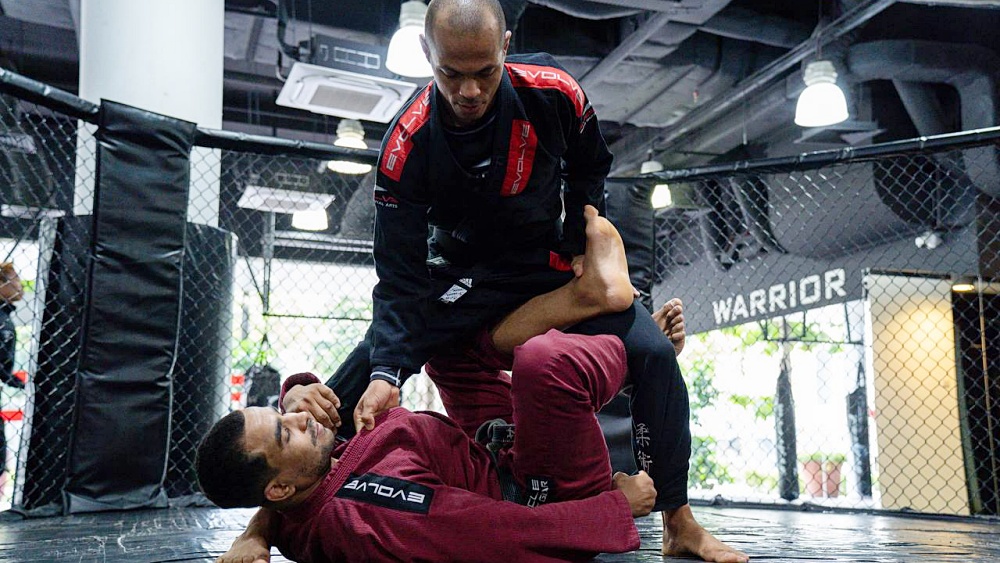Brazilian Jiu-Jitsu is a ground-based fighting style that has rapidly evolved over the past decades. As Jiu-Jitsu has grown, so have its positions and techniques, each bringing a unique set of advantages to the table. Among the various guard variations that have emerged, the X-guard stands as a bridge between the old school and the new guard. Today, we’ll go over the basics of this timeless guard position.
Defining The X-Guard
The X-guard is an open-guard variant popularized by the legendary Marcelo Garcia in the 2000s. It is a type of open guard that relies on off-balancing the opponent to create situations to sweep or wrestle up. The key to a successful X-guard is to place yourself directly underneath the opponent’s center of gravity, configuring your legs to the shape of an “X”, thus limiting your opponent’s defensive movements. We will dive deeper into the mechanics and techniques as we go along.
Beginnings And Evolution
The X-guard’s origins are ambiguous at best, with several stories popping up now and then. The position, however, gained distinction in the early 2000s, with world-class competitors, such as the aforementioned Marcelo Garcia, showcasing its effectiveness in various competitions. Since then, it has become a staple in the arsenal of many Jiu-Jitsu athletes, from amateurs to world champions.
Benefits Of Using The X-Guard
The main benefit of the X-guard lies in its ability to off-balance (Kuzushi) and control the opponent while you are supine. With the legs forming an “X” underneath the opponent, you can easily disrupt their base, making it difficult for them to maintain stability. This inherent instability provides numerous opportunities to execute sweeps and transition to dominant positions.
Also, the X-guard’s “sticky” nature makes it difficult for the opponent on top to move to an offensive cycle. They cannot just move without thinking, or else they’ll fall down instantly. For as long as the opponent is stuck inside your X-guard, it is safe to say that you have the upper hand, at least in terms of keeping yourself safe and getting more opportunities to attack.
Types Of X-Guards
Before we move to the actual technique, it is essential to note that there are many types of X-guards in BJJ. This article will not break down all variations, except for the standard version, but this video should be a solid starting point for explaining the intricacies of each type. Remember that the best way to learn new techniques is to take it slow and learn one move at a time. For now, use this video as a reference or guide on what you can learn from studying the X-Guard. Make it a point to follow a plan whenever you add new weapons to your game. This will make you more mindful of the techniques you wish to learn.
The X-Guard In Action
In this video, BJJ Black Belt Lachlan Giles shares the mechanics of the X-Guard (standard variation), from entry, maintenance, and the sweep. He starts by demonstrating an entry from the butterfly guard. The butterfly guard is by far the most common open guard in No-Gi grappling, and it is an excellent starting point to move to the X-Guard. From the butterfly guard, get the inside position and push them up and forward by posting near their armpits. This should force your opponent to move past your head and post their feet on the mats.
From here, hook one leg as you shift underneath their body. Use your legs to form an “X” shape, with one leg blocking near the knee and the other near the hip. Ensure that you keep everything tight and remove the slack as much as you can. To help you visualize this better, imagine that you are expanding the opponent’s base by flaring your hooks in opposite directions. Keep a tight grip on your opponent’s kneecap to prevent them from running away, and tilt them sideways with your knee as you flare your legs. These steps will ensure you maintain the X-Guard even against strong training partners.
For the finish, he teaches the classic technical standup sweep. Force the opponent to shift sideways as you remove your top hook. Place your foot on their thigh as you kick and go up while maintaining the other leg with your grip. The movement should look like the basic technical stand-up you learn as a white belt. Once you get up, you can go to the back or finish with the takedown.
Path To The X-Guard
What makes the X-guard such an effective position is its versatility. This is a guard that works well in both Gi and No-Gi Jiu-Jitsu. It can even work in MMA, provided you enter the position safely (as the threat of strikes is always looming). It is also a good secondary guard to the butterfly and single-leg X, making it an essential tool for guard specialists. While it may require several steps to enter the X-guard, it is perhaps one of the best open guards to dominate your opponents once you get to the position.
Mastering The X-Guard
Like all techniques in BJJ, mastering the X-guard requires dedication, understanding, and countless hours of practice. It’s essential to drill the position regularly, focusing on entries, sweeps, and transitions. Sparring provides the platform to test the effectiveness of the X-guard against resisting opponents and to adapt to various defensive strategies.
Furthermore, studying matches of high-level competitors who excel in the X-guard can offer valuable insights. Observing their setups, sweeps, and adjustments can provide a deeper understanding of the position’s intricacies.
Conclusion
In conclusion, the X-guard is a testament to the ever-evolving nature of Brazilian Jiu-Jitsu. It embodies the art’s principles of leverage, control, and technique. As BJJ continues to grow and evolve, we believe that positions like the X-guard will remain relevant. This fantastic guard will always be a valuable tool for grapplers today and in the future. Try it today and see if the X-guard works for you.
You may also like:
















